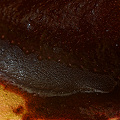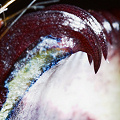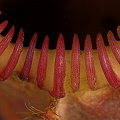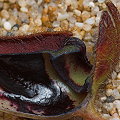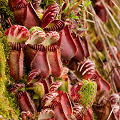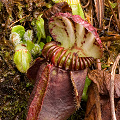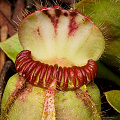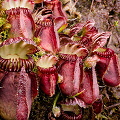Q: Cephalotus: the Albany pitcher plant
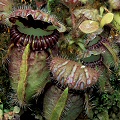
Cephalotus: Grrrrrr!
A: Cephalotus follicularis is an absolutely fabulous
looking plant from southwest Australia. A pot of these bizarre little things look so grotesquely bizarre, you expect their lids to
start
flapping at you any second as they start singing a happy little puppet song or demand a blood sacrifice immediately
(depending upon which kind of movie your life is).
Really, this rosetted plant is remarkable. Not very large---the biggest, grandest clumps of pitchers are only about 60 cm in diameter),
the rosettes consist of two types of leaves. One kind is flat, a few to several cm long, and somewhat tonguelike.
The other kind is dramatically transmogrified into a complex pitcher shape of similar size to the foliage leaves.
(Very occasionally, mutant intermediate leaves are produced.)
The pitchers are marvels of adaptation. Flanged wings on the pitchers might function as insect highways, drawing prey up to the pitcher mouth.
A lid with windows allows in light, but prevents the pitcher from overfilling with rain. It probably also helps retain prey
(although, like all other lidded pitcher plants, there is no opening or closing activity associated with trapping). A
peristome around the mouth is festooned with glands. Prey that fall into the pitcher find escape impossible because of the
microscopic downward-pointing projections on the slippery pitcher walls,
and a nasty overhanging ceiling they cannot navigate around. Each pitcher is filled with fluid, exuded by
comparatively large (0.2 mm diameter) domelike glands. There is some opinion that
this plant specializes in trapping ants, although field researchers often report a variety of captured prey.
Once inside, insects must contend with the dread gland patch. Ahh, the gland patch. This elongated patch near the bottom of
each picher is covered with tiny (0.02 mm diameter) glands that secrete digestive enzymes.
Eesh!
The common name, Albany pitcher plant, merely indicates that this plant is found near the Australian town of Albany. The
Latin name translates, strangely enough, to "the sack-bearing, headed one". Although this sounds like some horrible kind
of schoolyard insult that got messed up on the delivery, it actually is a convoluted set of botanical references.
The "sack" refers to the pitchers, while the "headed"
refers to the shape of the flower's anthers. Hmmm, a pretty damn strange of a strange choice of epithets, in my opinion.
The entire plant is covered with so many little bristles it has been called a "vegetable hedgehog." This is the kind of
historical oddity in which I delight.
Page citations: Juniper, B.E., et al. 1989; Lowrie, A. 1998, 2013;
Rice, B.A. 2006a; personal observations.
